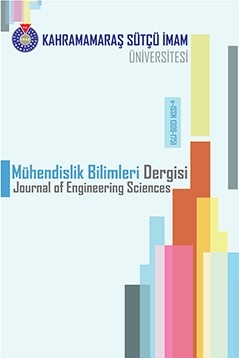Kavak odununun kimyasal özellikleri üzerine termal ve basınçlı termal modifikasyon işlemlerinin etkisi
Termal işlem, termal basınç, kavak, kimyasal özellikler
Effects of the termal and pressurised thermal modification treatments on chemical properties of the poplar woods
Thermal process, thermal pressure, poplar wood, chemical properties,
___
- Akyıldız, M.H., Ateş, S., and Özdemir, H., (2009), “Technological and chemical properties of heat-treated Anatolian black pine wood”, African Journal of Biotechnology, 8(11): 2565-2572.
- Atik, C., (1995), “Titrek Kavak (Populus tremula L.) ve Kağıt Sanayii”, İ.Ü. Fen Bilimleri Enstitüsü Yüksek Lisans Tezi, İstanbul, sayfa: 1-71.
- Bal, B.C., Bektaş, İ, 2012, The effects of heat treatment on the physical properties of juvenile wood and mature wood of Eucalyptus grandis. Bioresources 7(4): 5117-5127.
- Bal, B.C., 2013a, Effects of Heat Treatment on the Physical Properties of Heartwood and Sapwood of Cedrus Libani. Bioresources 8(1):211-219.
- Bal. B.C., 2013b, A Comparative Study of the Physical Properties of Thermally Treated Poplar Wood and Plane Wood, Bioresources 8(4):6493-6500.
- Balatinecz, J., Kretschmann, D.E., (2001), “Properties and Utilization of Poplar Wood, Poplar Culture in North America”, The 21st session of the International Poplar Commission, National Research Council of Canada.
- Batista, D.C., Muniz, G.I.B., Oliveira, J.T.S., Paes, J.B., Nisgoski, S., 2016. “Effect of the Brazilian thermal modification process on the chemical composition of Eucalyptus grandis juvenile wood – Part 1: Cell wall polymers and extractives contents”, Maderas, Cienc. tecnol. vol.18 no.2, http://dx.doi.org/10.4067/S0718-221X2016005000025
- Birler, A.S., (2010), “Türkiye’de kavak yetiştirme fidanlık – ağaçlandırma – koruma hâsılat – ekonomi – odun özellikleri”, Çevre ve Orman Bakanlığı Yayın No: 393 ISSN: 1300-395X, Araştırma Müdürlüğü Yayın No: 262, çeşitli yayınlar serisi No: 22, İzmit, sayfa:224.
- Cabalova, I., Kacík, F., Tribulova, T., (2016), “The Effects of Heat Treatment on the Chemical Alterations of Oak Wood”, Trans Tech Publications, Key Engineering Materials.
- Esteves, B.M., Pereira, H.M., (2009), “Heat treatment of wood”, Bioresources”, 4(1).370-404.
- Gündüz, G., Aşık, A., Aydemir, D., Kılıç, A., (2015), “Bakteriyel selüloz üretimi ve karakterizasyonu”, Düzce Üniversitesi Ormancılık Dergisi, 10(2), 1-10.
- Hill, C., (2006), “Wood modification –chemical, thermal and other processes”, Wiley Series in Renewable Resources, Jhon Wiley & Sons. Ltd.
- Huş, Savni, (1959), “Kavak odununun kimyevi yönden değerlendirme imkanlari”, İ.Ü Orman Fakültesi Dergisi, Seri B, Cilt IX, Sayı II, sayfa: 46.
- Militz, H., (2002), “Thermal treatment of wood. European process and their background”, In: Cardiff-Wales, IRG/WP02 40241 33rd. Annual Meeting.
- Öner, N., Aslan, S., (2002), “Titrek kavak (Populus tremula l.) odununun teknolojik özellikleri ve kullanım yerleri”, Süleyman Demirel Üniversitesi, Orman Fakültesi Dergisi, Seri: A, Sayı: 1, ISSN: 1302-7085, Sayfa:135-146.
- Patzelt, M., Emsenhuber, G. and Stingl, R., (2003), “Color measurement as means of quality control of thermally treated wood”, Abstracts of the First European Conference on Wood Modification, Chent, Belguim.
- Shafizadeh, F., Chin, P.P.S., (1977), “Wood techonology; Chemical Aspects”, American Chemical Society. Washington.
- Toplu, F., (1999), “Fırat Kavağı”, Güneydoğu Anadolu Ormancılık Araştırma Enstitüsü Yayınları, Çeşitli Yayınlar Serisi No:1, Cilt No: 688, Sayfa: 44-49.
- Wenzl. H., (1970), “The Chemical Technology of Wood”, Academic press, New York, p: 684.
- Yıldız, S., (2002), “Isıl İşlem Uygulanan Doğu Kayını Ve Doğu Ladini Odunlarının Fiziksel Teknolojik ve Kimyasal Özellikleri”, Doktora Tezi, K.T.Ü. Fen Bilimleri Enstitüsü, Trabzon.
- Başlangıç: 1998
- Yayıncı: Kahramanmaraş Sütçü İmam Üniversitesi
Giyilebilir Elektronik/Akıllı Tekstiller ve Uygulamaları
Mahmut ALTUN, İbrahim KARTERİ, Mahit GÜNEŞ, Mehmet Hakkı ALMA
Merkezi Isıtma Sistemlerinde Verimi Artırmak İçin Dinamik Kontrol ve Otomasyon Uygulaması
İbrahim BEKTAŞ, Gonca DÜZKALE SÖZBİR, Bekir Cihad BAL, Ertuğrul ALTUNTAŞ
KUZEY IRAK’TA ÜRETİLEN TAVUK ETLERİNDE SALMONELLA İZOLASYONU
Abdulrezzaq Haji Haji, Ahmet İNANÇ
Nemrut Bay Seawater Quality Assessment at the Planning Stage of Marine Outfall
Mustafa KAPTANOĞLU, Mehmet EROĞLU
Tekstil Makinelerinin Harmonik ve Güç Kalitesine Etkilerinin İncelenmesi
